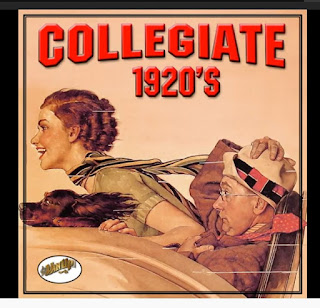Rah-Rah Rudy -- Garbo
Rudy Vallee began his career in the 1920s, when American was college-crazy, as we sell in the movies and music of that time. Rudy was famous for his megaphone, which he used to sing into microphones while recording and also in live venues, to make himself heard while people were dancing. Megaphones are also a tool for cheerleaders, and in Rudy's day, male cheerleaders, aka "yell leaders," holsted large wooden megaphones to reach the fans in the top row of the stadium bleachers. So what began as a symbol of a band singer also stood for a guy who was a Big Man on Campus.
You can see from this still from the musical short "Betty Co-Ed" that Rudy fit the bill for the BMOC look. There's a large N.Y.U. pennant behind him, and a smaller one for Yale. Now check out the pennants in the cartoon portion of "Bedy Co-Ed."
Okay, first, you're thinking "That's Betty Boop???" The character had several looks in the cartoon, and you can see that she's unrecognizable in this scene where she's leading a cheer from the top of a piano, especially with a cap over one of her googly eyes and with her tongue sticking out.
But now check out the pennants -- there's the same Yale one as in the picture of Rudy at the top of this page, and there's also a pennant that says Maine.
Rudy Vallee was born in Vermont and he grew up in Maine. After altering his birth date to enlist during World War I, Rudy was discharged as too young to serve. He spent a couple of years in England as part of London's jazz scene. But the band he was with wanted only his saxophone and he wanted to sing. So he came back to the State. Rudy attended the University of Maine for a year, up near Bangor, and that's why there's a Maine pennant in the Betty Boop cartoon. This also explains Rudy's lifelong connection with the University, starting with his hit version of the school song.
University of Maine students celebrate Rudy Vallee's birthday every year by playing "The Stein Song." You can watch the Zoom version here. And here is a whole wiki article on "The Stein Song."
After his year at the University of Maine, Rudy attended Yale, which explains the other pennant in the images above, and why his most famous band was called The Connecticut Yankees.
Before the Connecticut Yankees, Rudy's band was the Yale Collegians.
Rudy was the lead vocalist, and doubled on saxophone and clarinet. In the video still below, we see the rakish top hat on Rudy's head. It got there during the change from sax to clarinet. When Rudy takes up the clarinet, another member of the band has pulls a toy white rabbit out of the top hat pops it onto Rudy's head just before the solo.
In this next video clip, the Collegians are wrapped up in raccoon coats and "Doin' the Raccon."
And here are the Collegians doing that feminist classic "You'll Do It Someday So Why Not Now?" At least you get to see the white rabbit come out of the top hat.
Speaking of women's roles in the 1920s, "Betty Co-Ed" hints that Betty is in college not to learn anything but to earn her "MRS degree."
To start with, all we really know about Betty are the details of how she looks. And all the boys she goes out with. Sigh.
Here's the whole "Betty Co-Ed" musical short. [This odd image is a college boy-dog in a beanie and college sweater. The dog has big square teeth and he is grinning with one of his hand-paws behind his floppy dog ear, because he hears Rudy Vallee's voice coming from an open window.]
The instrumental music made by animals (and ON animals) in "Betty Co-Ed" is the hit song "Collegiate." Here's a well-known version of the song by bandleader Fred Waring
A couple more college-themed numbers by Rudy Vallee:
The Varsity Drag
The Whiffenpoof Song
To finish up today, here's a film still from 1933's "International House," from the scene in which Rudy croons a lullaby to his megaphone before putting it to bed.
Garbo











Comments
Post a Comment